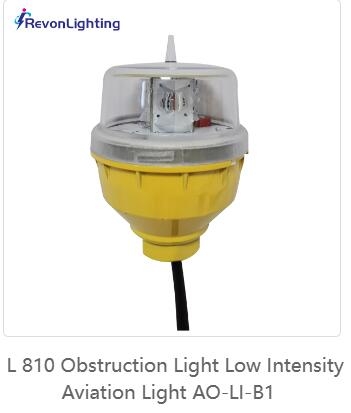Posted: 2024-06-14
FAA Type L-810 obstruction lights play a crucial role in aviation safety by providing essential warning signals to aircraft regarding the presence of obstacles near air navigation structures. These lights are specifically designed and regulated by the Federal Aviation Administration (FAA) to ensure the safe and efficient operation of the national airspace system. This article explores the significance, regulations, and importance of FAA Type L-810 obstruction lights in enhancing aviation safety.
Significance of FAA Type L-810 Obstruction Lights:
FAA Type L-810 obstruction lights are low-intensity red lights used for marking structures that are under 200 feet in height, such as buildings, antennas, and small towers. These lights emit a steady red glow that serves as a visual alert to pilots, indicating the presence of potential obstacles in their flight path. By incorporating Type L-810 obstruction lights, aviation authorities can enhance the visibility of structures and minimize the risk of collisions, especially during low visibility conditions or nighttime operations.
Regulations Governing FAA Type L-810 Obstruction Lights:
The installation and operation of FAA Type L-810 obstruction lights are governed by strict regulations established by the FAA. These regulations are outlined in FAA Advisory Circular 70/7460-1L, which provides detailed guidelines on the marking and lighting requirements for structures that may affect air navigation. According to these regulations, Type L-810 lights must meet specific criteria regarding light intensity, color, and placement based on the height and location of the structure. Regular inspections and maintenance of Type L-810 obstruction lights are also mandated to ensure compliance with regulatory standards and the continued effectiveness of the lighting system.

Importance of FAA Type L-810 Obstruction Lights:
FAA Type L-810 obstruction lights play a critical role in enhancing aviation safety by increasing the visibility of low-lying structures to aircraft. These lights serve as important visual aids for pilots, helping them to identify obstacles and navigate safely around them. By alerting pilots to the presence of structures through a steady red light, Type L-810 obstruction lights contribute to the prevention of accidents and the efficient flow of air traffic. Their compliance with FAA regulations ensures the consistent and reliable operation of the lighting system, further enhancing the safety of air navigation.
| faa type l 810 | Obstruction Lights |
| 22 | 33 |
| 34 | 45 |
Technological Advancements:
In recent years, technological advancements have led to improvements in FAA Type L-810 obstruction lights, enhancing their performance and reliability. LED technology has been widely adopted in Type L-810 lights due to its energy efficiency, long lifespan, and high visibility. LED obstruction lights offer a bright and uniform light output, making them easily discernible to pilots from a distance. Additionally, the integration of smart control systems enables remote monitoring and management of Type L-810 obstruction lights, allowing for real-time status updates and quick response to any malfunctions. These technological advancements contribute to the overall effectiveness and safety of FAA Type L-810 obstruction lights in aviation operations.
Conclusion:
In conclusion, FAA Type L-810 obstruction lights play a crucial role in enhancing aviation safety by providing vital warning signals to pilots regarding obstacles near air navigation structures. By adhering to strict regulations and incorporating advanced technologies, Type L-810 lights aid in preventing collisions, improving visibility, and ensuring the safe navigation of aircraft. As aviation continues to evolve, the importance of FAA Type L-810 obstruction lights in safeguarding the skies and enhancing air navigation systems cannot be overstated. Their reliable and efficient operation contributes to the overall safety and efficiency of the national airspace system, making them indispensable components of modern aviation safety protocols.